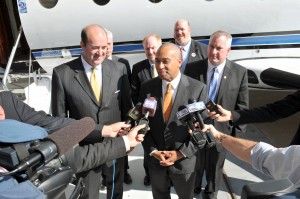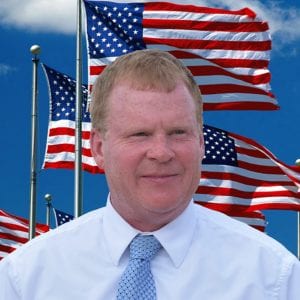
Gov. Deval Patrick, center, is interviewed at Westfield-Barnes Regional Airport during a tour of Gulstream Aviation in October. The company announced it will expand its operation and service center in Westfield. (File photo by chief photographer Frederick Gore)
WESTFIELD – The construction projects which have frustrated city residents for the past three years are beginning to pay dividends, Mayor Daniel M. Knapik said recently.
“I think that we’ll all be very pleased to see the end of our two very large construction projects this summer,” Knapik said. “Our traffic congestion is abating, but even more importantly; those improvements are setting the table for more economic development.”
“Now, all of a sudden, people are taking notice of the opportunities we have here in Westfield,” he said. “Real economic development is happening here, something that you don’t see in a lot of area communities.”
City Advancement Officer Jeff Daley said recently that City Advancement Officer Jeff Daley said that 20 projects, with a total investment value of more than $60 million, have committed to locating or constructing new facilities in the city.
“Over the past 18 months we have 20 active projects investing $61,930,000 in Westfield and another 23, with a value of $30 million trying to close, but at various stages,” Daley said.
“The highlight of the year is Gulfstream, which plans to build a 100,000-plus square-foot facility,” Daley said.
Gulfstream Aerospace Service Corporation signed a 50-year lease, with an option for a second 50 years, and will invest $20 million in infrastructure and machinery at Barnes Regional Airport.
The Armbrook Senior Living Center, to be constructed off North Road just west of Southampton Road, is another $20 million investment in the city. That project calls for a 137 room senior living facility that will offer options of independent living, assisted living and memory care services.
The City Council and the state Economic Assistance Coordinating Council voted to approve the local and state tax incentive packages for Gulfstream Aerospace Service Corporation; Seal Ryt Corporation, which recently relocated from Easthampton to Servistar Industrial Road; and the Armbrook Senior Living, LLC. The three projects will collectively create more than 150 full-time and 100 part-time jobs, and increase the city’s commercial tax base.
Knapik said that the millions invested in public infrastructure projects are beginning to stimulate private investment in the city’s core district. Rocco “Rocky” Falcone is a major player in the private investment arena. His project includes the construction of new Rocky’s Ace Hardware store, as well as investment into his properties along Main Street next to the hardware store.
“Rocco is rehabbing those buildings, to create residential housing on the second story,” Knapik said. “Housing in the downtown is in demand, so there is that opportunity.”
“Rocco was in recently with the folks from Walgreen’s to talk about improvements to that property. The drug store is looking to install a drive-thru window at the back of the building,” Knapik said, “cleaning up the facade and dressing up the parking area.”
“Walmart is on track to get their expansion done this year, Bob Bolduc is starting his gas station project this year at the Turnpike Exchange and Friendly’s is redoing their building,” he said. “I’m excited to have something going on up there at the turnpike.”
The city is moving forward with infrastructure improvements near the turnpike exchange.
“We will do the Arch Road improvements this summer and we plan, for 2013-14, to revamp the turnpike exchange and add a slip ramp to the eastbound lane of the turnpike, as well as improvements, dedicated left turn lanes at the bottom of Clay Hill (the intersection of Notre Dame and North Elm Streets).”
“All of this infrastructure work needed to be done,” he said. “Granted we will have to do more construction, but nothing at the massive level of the past few years.”
That public-infrastructure investment is now bearing the fruit of private investment.
“We knew this would happen, that as we improved city property, the private property owners would follow suit and invest in their properties. We’re seeing that now in the downtown corridor,” Knapik said.
Another public project that will have a direct economic incentive for private investment is the Columbia Greenway Bicycle Trail. The city recently received a $1 million state grant to extend the trail from the Southwick line to just south of Tin Bridge over the Little River. That work is expected to begin this spring.
“This is the start of a four-year construction process, after 15 years of talking about it,” Knapik said. “That trail will be a game changer for the downtown. We anticipate that there will be 250,000 people using that trail a year.
“The economic impact of that is huge. The typical bicyclist spends between $8 and $15 a day which translates into more opportunity to see more businesses targeting that market,” he said. “During the next two years I hope to extend the trail to the south side of Main Street, to the Stop & Shop parking area.”
“The TIP (Transportation Improvement Program) has money earmarked for the north section (between Orange Street and Women’s Temperance Park on the north bank of the Westfield River) for 2014, and then we’ll finish the middle part linking the entire trail through the heart of the city.”
Knapik said that the city’s financial position has improved during his tenure in office and that he anticipates increasing the city’s reserve funds by between $500,000 and $1 million this year.
“We have $6.2 million in the stabilization reserve accounts and I’d like to increase that to between $6.5 and $7.5 million this year,” he said. “For years we didn’t have a stabilization account, which is critical because it allows you to do things that benefit the city.”
One of the major benefits of a healthy stabilization account is the bonding agencies look for that conservative fiscal planning.
“That communicated to Wall Street that our economic health is strong. Increasing the stabilization account to $7 million will help us keep those high bond ratings which translate into low-interest rates on bonds.”
“We have $2 million in free cash, but I may have to use some of that for the 2013 budget or to balance this year’s budget.”
“We also have spent, just in Department of Public Works funding, $220,119 for the tornado cleanup and $1,026,692 for the October Storm cleanup,” Knapik said. “Some things we can’t anticipate are those kinds of events, we can’t budget for that. Luckily, we’ve had a relatively mild winter because our snow budget was spent in that one storm.”
The Federal Emergency Management Agency just sent the city a check for $180,000. That funding is not related to any of the four weather related emergencies that occurred in 2011. The check is reimbursement for city funds spent during a storm that occurred in April of 2007.
“It was reimbursement for work we had to do on Little River Road following a flood, but it took five years for that process,” Knapik said. “We have to pay our contractors hired in the aftermath of these storms, then wait years for the federal money to come back to the city.”
Knapik said that, even with cuts in state local aid, the city has been in a financial position to move projects forward.
“The state government’s biggest commitment should be to cities and towns,” Knapik said. “The big issue for cities is that Chapter 70 (education) funding continues to be underfunded, which is manifesting itself in larger class sizes. We’re still $2 billion short of the full Chapter 70 funding required in the legislation passed 20 years ago.”
The other issue for municipalities is state and federal unfunded mandates, state and federal requirements for facilities that are financed with city funds.
The newest of those unfunded mandates is the requirement for medical dispatch centers.
“Is this a good time to have to hire three additional dispatchers and a supervisor, adding four positions and $250,000 to the city’s payroll?” Knapik said. “It’s difficult to swallow when there is no state funding available.”
“But it does set us up as a regional dispatch center, a good thing for the city’s future. We will meet the state’s requirement to have that facility in operation by July 1,” he said.
The third issue for cities and towns is that as federal and state aid evaporates the cost of municipal operations is increasingly shifted to property taxes.
“The reliance on property taxes increases while everything else is being cut,” he said.
A fourth issue for municipalities is that as state and federal funding decrease, cities and towns were faced with hard financial choices, frequently deferring maintenance of municipal buildings.
“For decades we deferred that maintenance. We’re paying for that now,” Knapik said. “We’re beginning to take care of that backlog of maintenance issues and will continue to do projects to improve the city’s building infrastructure.”
“We’re in a position where we’ll be able to afford building maintenance, projects to increase energy efficiency,” he said. “Building maintenance over the next five to six years will be a large part of the city budget.”







